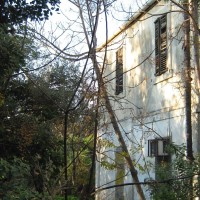
If you search for ‘urban decay’ on the Flickr-webs you get thousands of photos of dilapidated tower blocks, crumbling tenements, abandoned factories, and shored-up houses. Oh, and a healthy dose of makeup, too. There are some really gorgeous shots amongst them, but then, when I was perusing the BBC news website today – as I am wont to do – I was reminded of the hundreds of abandoned settlements that populate the British countryside.
The majority of these villages and small towns are barely identifiable today; they were depopulated through plague and war and have collapsed into nothingness over time, to be ploughed over and are now just fields. Some have surrendered themselves to the sea owing to coastal erosion or have been flooded to create reservoirs. But there’s also a small selection of villages that were taken over by the army during the Second World War and now serve as time capsules for the fateful day, sometime in the 1940s, when their residents packed whatever they could carry, and left.
Many of these villages remain under army control and are completely inaccessible, but there are a couple that enjoy limited access and they strike me as places that would be wonderful to explore and photograph: Tyneham in Dorset and Imber in Wiltshire. Tynham is open most weekends throughout the year, but access to Imber is more restricted. You could head to Tyneham this weekend, if you fancied, but would have to wait until 17 December to get into Imber.
I’m going to try to plan a visit to one of them soon. I’m intrigued. If you’d like to plan an excusrion, more information is available from Tyneham.org and Forever Imber.





